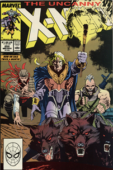 The Uncanny X-Men #252, Wolverine #15, Amazing Spider-Man #324, Excalibur #15, Marvel Comics Presents #36.
The Uncanny X-Men #252, Wolverine #15, Amazing Spider-Man #324, Excalibur #15, Marvel Comics Presents #36.
Theme Music:
Lazlo Hollyfeld – Buffaloallamericacity
Podcast (dangerroompodcast): Play in new window | Download
Subscribe: RSS
Danger Room: The X-Men Comics Commentary Podcast
Adam and Jeremy lovingly recap the X-Men Universe issue by issue.
 The Uncanny X-Men #252, Wolverine #15, Amazing Spider-Man #324, Excalibur #15, Marvel Comics Presents #36.
The Uncanny X-Men #252, Wolverine #15, Amazing Spider-Man #324, Excalibur #15, Marvel Comics Presents #36.
Theme Music:
Lazlo Hollyfeld – Buffaloallamericacity
Podcast (dangerroompodcast): Play in new window | Download
Subscribe: RSS
Guys, congratulations on the upcoming 300th episode of the Danger Room Podcast. Give yourselves a virtual pat on the back for your sheer endurance and commitment to the project.
On issue #252:
1) That voice you gave to Jubilee… wow, that impression will now have a permanent home in my head. Reading issue #303 is going to be a challenge when you eventually get to it.
2) I’m probably in the minority but I have always really dug Rick Leonard’s work. I met him at Albany Comic Con a couple years ago, before the era of social distancing. He was generous to do a free Wolverine portrait as a ‘thank you’ to me for buying some of his original comic pages (from a Dazzler backup story in Classic X-Men #37, with Bob McLeod on inks). Looking at the original, uncolored work makes his stuff look even better; he’s really quite good at layouts and using negative space. If it’s any consolation to his detractors, he’ll only pencil a total of 2 more pages during the remainder of Claremont’s X-Men career. Blink and you’ll miss it.
On the Pierce/Lady Deathstrike reply:
I won’t belabor my point too much, just elaborate that I viewied this interaction in the context of hierarchies and how they inform behavior, even behavior represented in fiction. For instance, The Reavers are a good example of a dominance hierarchy, and Pierce (by means of his specific villain archetype, that of The Psychotic) is at the top of that hierarchy. In that context, it’s not unusual that subordinates (even ones as fierce or as cagey as Lady Deathstrike) would behave differently than they otherwise would independent of that structure. Conversely, it also wouldn’t be unusual to see subordinates challenge or usurp that symbol of power, as happened in issue #252 with Deathstrike violently rebuking an advance that overstepped a boundary of tolerance. Hierarchies organized around dominance and nihilism are intrinsically unstable. I think that point was the main take-away from this Piece/Deathstrike thing that’s been going on. You’re right, having more dialogue to emphasize this point isn’t an unreasonable request, but I personally think enough non-verbal and symbolic information was provided for the audience to infer meaning and motivation. Afterall, children as young as infants and toddlers can understand social hierarchies and what happens in them. As adults we might sometimes underestimate how much kids are cognitively capable of.
Anyway, great stuff. You’re getting closer to my favorite issue of all time (another good example of challenging kids’ inferencial abilities and capacity for inquiry). I’ll reveal what issue this is once you finally review it.
Later
An addendum:
To clarify, children BEGIN to understand and assimilate the concept of hierarchies as infants and toddlers. I didn’t mean to suggest that infants could read and understand the subtexts of an issue of the X-Men, I just meant that kids that were reading X-Men in 1989 had already been operating on software that for years was recognizeing and building internal schema for interpreting interactions with a complex social world, including representation of it in stories. Had to clarify out of habit.
“The developmental origins of social hierarchy: how infants and young children mentally represent and respond to power and status”
https://doi.org/10.1016/j.copsyc.2019.07.044